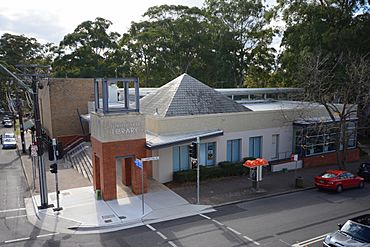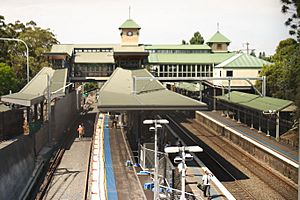Pennant Hills, New South Wales facts for kids
Quick facts for kids Pennant HillsSydney, New South Wales |
|||||||||||||||
|---|---|---|---|---|---|---|---|---|---|---|---|---|---|---|---|

Pennant Hills Library, Yarrara Road
|
|||||||||||||||
| Population | 7,588 (2021 census) | ||||||||||||||
| Postcode(s) | 2120 | ||||||||||||||
| Elevation | 167 m (548 ft) | ||||||||||||||
| Location | 18 km (11 mi) north-west of Sydney CBD | ||||||||||||||
| LGA(s) | Hornsby | ||||||||||||||
| Region | Northern Sydney | ||||||||||||||
| State electorate(s) | Epping, Hornsby, Wahroonga | ||||||||||||||
| Federal Division(s) | Berowra | ||||||||||||||
|
|||||||||||||||
Pennant Hills is a suburb located in the Northern Sydney area of Sydney, New South Wales, Australia. It is about 18 kilometres north-west of the main city centre of Sydney. This suburb is part of the Hornsby Shire local government area.
Contents
Discovering Pennant Hills: A Look at Its Past
The area around Pennant Hills was first explored by Governor Arthur Phillip in 1788. His group saw amazing views of the Blue Mountains in the distance. They thought a large river might be nearby.
The first European settlers were convicts who set up timber camps. This happened during the time of Governor Lachlan Macquarie. People started to settle permanently in Pennant Hills in the 1840s. More people moved here when the Northern railway line opened in the 1880s. In 1912, the government opened a special Wireless Telegraphy Station. This was the first of its kind in Australia. The suburb has grown a lot since the 1950s, when cars became very common.
How Pennant Hills Got Its Name
There are two main ideas about how Pennant Hills got its name. One idea is that people used to raise flags, called pennants, here to send signals. However, records show this type of signalling was used in a different area. Also, the name 'Pennant Hills' appeared in older documents. For example, in 1801, it was listed as a place where someone lived.
Another idea, suggested by a historian in 1920, is that the area was named after Thomas Pennant. He was a famous British scientist who studied birds and animals. Even though he never came to Australia, he knew important people like Joseph Banks and Captain James Cook. Back then, explorers often named places after people who supported them.
The name Pennant Hills first referred to the area now called West Pennant Hills. But when the railway line was built, it went through the current Pennant Hills. So, a town grew around the station and took the name. The area around Thompsons Corner was then renamed West Pennant Hills. Pennant Hills is quite hilly. The highest point is Observatory Park, where an old astronomical observatory used to be.
Shopping and Fun in Pennant Hills
Pennant Hills is a busy shopping area in Hornsby Shire. You can find many shops north-west of the railway line. The local Pennant Hills Library is also there. There are also many restaurants and cafes along Yarrara Road. For more shopping, visit Pennant Hills Marketplace on Hillcrest Road.
You'll find homes all over Pennant Hills. Newer apartment buildings and offices are located along Pennant Hills Road. There's also a big area for businesses and factories along Pennant Hills Road.
Pennant Hills has places for entertainment too, like the Pennant Hills Hotel.
Getting Around Pennant Hills
The Pennant Hills railway station is on the Northern Line of the Sydney Trains network. This makes it easy to travel by train.
Pennant Hills Road is one of Sydney's main roads. Bus services run from Pennant Hills to places like West Pennant Hills, Castle Hill, and Cherrybrook.
Learning and Nature in Pennant Hills
Pennant Hills has several schools. There are two public schools: Pennant Hills Public School (opened in 1925) and Pennant Hills High School (opened in 1966). There are also two Catholic schools: Mount St Benedict College, a high school for girls, and St. Agatha's Catholic Primary School.
Parks and Bushland to Explore
Pennant Hills is surrounded by beautiful bushland. To the east, you'll find the Lane Cove River and Lane Cove National Park. To the north-west, it borders Berowra Valley National Park. Both parks have many walking tracks. Some of these tracks connect to the famous Great North Walk.
Pennant Hills also has many public parks. The biggest is Pennant Hills Park sportsground. This park has lots of sports facilities. It includes Ern Holmes Oval for Australian Football and cricket. There are also tennis and netball courts, a rugby field, a football pitch, and hockey fields. You can even find an archery range here!
Lilian Fraser Garden is another special place in Pennant Hills. A government scientist named Dr. Lilian Fraser cared for this garden for many years. After she passed away in 1987, her collection of rare plants was given to the Hornsby Shire Council. The garden is open to the public for free.
Sports and Activities for Everyone
Because of its many sports facilities, Pennant Hills is home to many sports clubs. The Pennant Hills Football Club started in 1957. The Pennant Hills Demons AFC is another club. Nine players from this club have gone on to play in the AFL. While the main team now plays elsewhere, many junior teams still play in Pennant Hills.
Pennant Hills also has the Baden Powell Scout Centre. It is next to the Lane Cove National Park. It opened in 1929 and was visited by Lord Baden-Powell himself in 1931. This centre is set on 36 acres of bushland. It offers accommodation and activities like high-ropes and rock climbing for groups.
The Pennant Hills Cherrybrook Rugby League Club, known as the Stags, is also from this area. They play at Greenway Oval in Cherrybrook. The Pennant Hills Park Tennis Centre is now part of Northwest Sydney Tennis. It has 16 courts with lights for night play.
Churches in Pennant Hills
Pennant Hills became a Catholic parish in 1928. Several Catholic churches have been built since then. The current St. Agatha's Church was built in 1979.
Pennant Hills is also home to the first Danish Church in Australia. In 2005, Crown Prince Frederik and Crown Princess Mary of Denmark visited this church.
Other churches in Pennant Hills include:
- St Mark's Anglican Church
- Pennant Hills Baptist Church
- Pennant Hills Uniting Church
- Thornleigh Seventh-day Adventist Church
Who Lives in Pennant Hills: Demographics
According to the 2021 census, 7,588 people live in Pennant Hills.
- The average age of people living here was 43 years. This is a bit older than the national average of 38 years.
- Children aged 0–14 years made up 17.1% of the population.
- People aged 65 years and over made up 18.7% of the population.
- About 57.0% of people were born in Australia. Other common birthplaces include China (8.4%), India (4.4%), England (3.1%), Korea (2.9%), and Hong Kong (2.8%).
- Most people (60.6%) speak only English at home. Other languages spoken include Mandarin (9.3%), Cantonese (5.8%), Korean (3.6%), Hindi (1.9%), and Arabic (1.4%).
- For religion, 36.1% said they had no religion. Catholic was 20.0%, and Anglican was 11.6%.
Famous People from Pennant Hills
Some well-known people have lived in Pennant Hills:
- James Milson, an early settler in the North Shore area.
- Philip Ruddock, who used to be Australia's Attorney General and is now the Mayor of Hornsby Shire.
- Lenny Hayes, a former football player for St Kilda and a winner of the Norm Smith Medal in 2010. He played for the Pennant Hills Demons.
- Mark McVeigh, a former football player for Essendon and coach for Greater Western Sydney. He also played for the Demons.
- Jarrad McVeigh, a former co-captain of the Sydney Swans premiership team. He also played for Pennant Hills Demons.
- John and Ilsa Konrads, a brother and sister who were world-record-breaking swimmers.
- Michaela Baranov, a contestant on the seventh season of The X Factor Australia.
- Geraint F. Lewis, an astrophysicist who works at the University of Sydney.
Pennant Hills Weather
Pennant Hills is quite high up, which affects its weather. It has an Oceanic climate. This means it has mild summers and cool winters. In summer, the high temperatures are about two degrees warmer than in central Sydney. In winter, they are about one degree cooler. Rain falls fairly evenly throughout the year. The wettest month is March, and the driest is September.
| Climate data for Pennant Hills | |||||||||||||
|---|---|---|---|---|---|---|---|---|---|---|---|---|---|
| Month | Jan | Feb | Mar | Apr | May | Jun | Jul | Aug | Sep | Oct | Nov | Dec | Year |
| Mean daily maximum °C (°F) | 27.6 (81.7) |
27.3 (81.1) |
25.5 (77.9) |
22.2 (72.0) |
19.1 (66.4) |
16.3 (61.3) |
15.8 (60.4) |
17.9 (64.2) |
20.9 (69.6) |
23.4 (74.1) |
25.1 (77.2) |
27.0 (80.6) |
22.3 (72.1) |
| Daily mean °C (°F) | 21.8 (71.2) |
21.7 (71.1) |
20.1 (68.2) |
17.0 (62.6) |
13.8 (56.8) |
11.3 (52.3) |
10.5 (50.9) |
10.9 (51.6) |
14.5 (58.1) |
17.1 (62.8) |
19.1 (66.4) |
21.0 (69.8) |
16.6 (61.8) |
| Mean daily minimum °C (°F) | 16.1 (61.0) |
16.1 (61.0) |
14.8 (58.6) |
11.8 (53.2) |
8.6 (47.5) |
6.3 (43.3) |
5.2 (41.4) |
6.1 (43.0) |
8.1 (46.6) |
10.8 (51.4) |
13.1 (55.6) |
15.0 (59.0) |
11.0 (51.8) |
| Average precipitation mm (inches) | 100.6 (3.96) |
115.8 (4.56) |
121.7 (4.79) |
104.5 (4.11) |
81.9 (3.22) |
111.4 (4.39) |
80.6 (3.17) |
63.5 (2.50) |
56.3 (2.22) |
69.0 (2.72) |
78.0 (3.07) |
92.1 (3.63) |
1,074.7 (42.31) |
| Average precipitation days (≥ 0.2 mm) | 10.6 | 11.4 | 12.1 | 11.3 | 9.5 | 10.9 | 9.2 | 8.5 | 8.8 | 9.5 | 9.9 | 10.6 | 122.3 |
| Source: Bureau of Meteorology (temperatures, 1907–1943) | |||||||||||||


